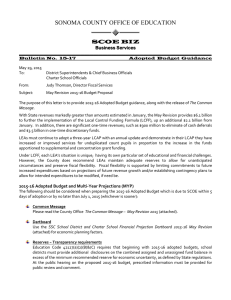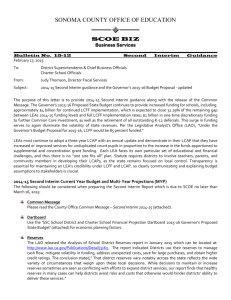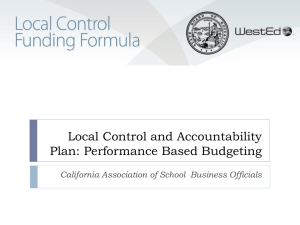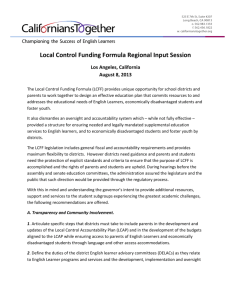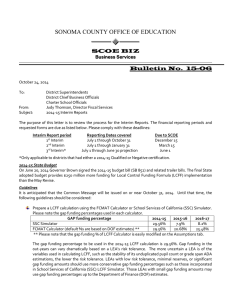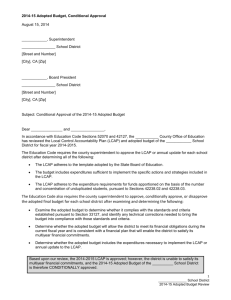CA-DOE-LCFF - California Adolescent Health Collaborative
advertisement
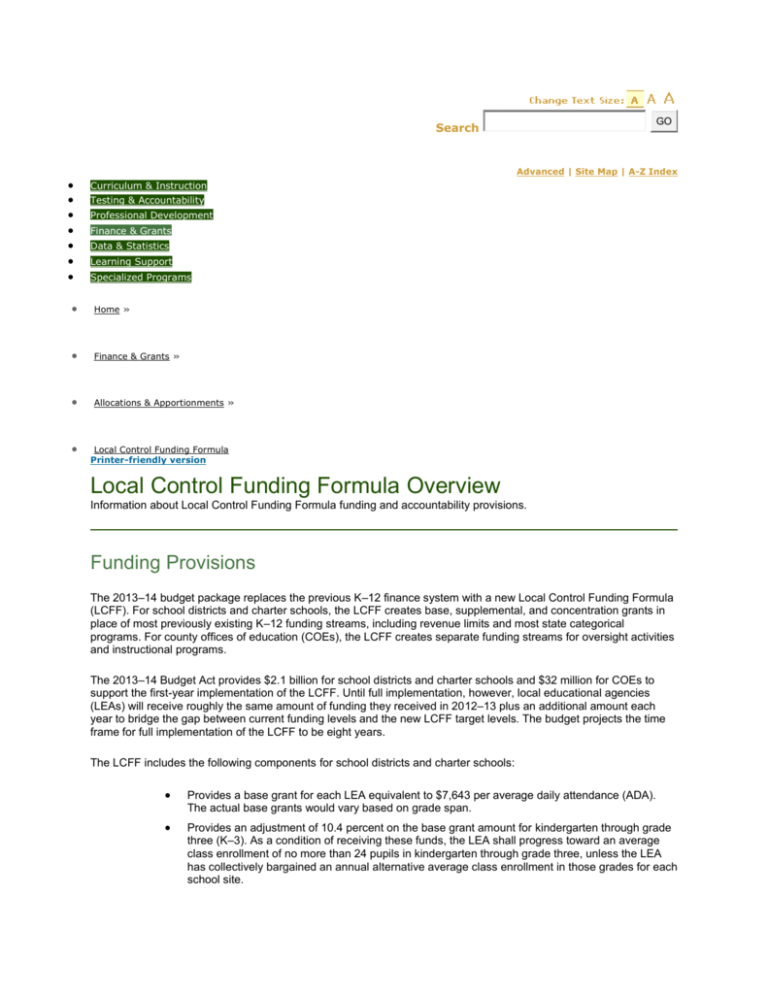
GO Search Advanced | Site Map | A-Z Index Curriculum & Instruction Testing & Accountability Professional Development Finance & Grants Data & Statistics Learning Support Specialized Programs Home » Finance & Grants » Allocations & Apportionments » Local Control Funding Formula Printer-friendly version Local Control Funding Formula Overview Information about Local Control Funding Formula funding and accountability provisions. Funding Provisions The 2013–14 budget package replaces the previous K–12 finance system with a new Local Control Funding Formula (LCFF). For school districts and charter schools, the LCFF creates base, supplemental, and concentration grants in place of most previously existing K–12 funding streams, including revenue limits and most state categorical programs. For county offices of education (COEs), the LCFF creates separate funding streams for oversight activities and instructional programs. The 2013–14 Budget Act provides $2.1 billion for school districts and charter schools and $32 million for COEs to support the first-year implementation of the LCFF. Until full implementation, however, local educational agencies (LEAs) will receive roughly the same amount of funding they received in 2012–13 plus an additional amount each year to bridge the gap between current funding levels and the new LCFF target levels. The budget projects the time frame for full implementation of the LCFF to be eight years. The LCFF includes the following components for school districts and charter schools: Provides a base grant for each LEA equivalent to $7,643 per average daily attendance (ADA). The actual base grants would vary based on grade span. Provides an adjustment of 10.4 percent on the base grant amount for kindergarten through grade three (K–3). As a condition of receiving these funds, the LEA shall progress toward an average class enrollment of no more than 24 pupils in kindergarten through grade three, unless the LEA has collectively bargained an annual alternative average class enrollment in those grades for each school site. Provides an adjustment of 2.6 percent on the base grant amount for grades nine through twelve. Provides a supplemental grant equal to 20 percent of the adjusted base grant for targeted disadvantaged students. Targeted students are those classified as English learners (EL), eligible to receive a free or reduced-price meal (FRPM), foster youth, or any combination of these factors (unduplicated count). Provides a concentration grant equal to 50 percent of the adjusted base grant for targeted students exceeding 55 percent of an LEA’s enrollment. Provides for additional funding based on an “economic recovery target” to ensure that virtually all districts are at least restored to their 2007–08 state funding levels (adjusted for inflation) and also guarantees a minimum amount of state aid to LEAs. The budget maintains Home-to-School Transportation and Targeted Instructional Improvement Block Grant funding as add-ons to the LCFF. The budget requires LEAs to maintain 2012–13 expenditure levels on transportation out of funds received for this purpose. A summary of the target LCFF funding amounts for school districts and charter schools is shown in Figure 1. Figure 1 Grade Span Funding at Full LCFF Implementation K–3 Class Average Average Average Average Size Assuming Assuming 0% Assuming 50% Assuming 100% Grade Base Reduction 25% Unduplicated Unduplicated Unduplicated Span Grant and Grades Unduplicated FRPM, EL, FRPM, EL, FRPM, EL, 9-12 FRPM, EL, Foster Youth Foster Youth Foster Youth Adjustments Foster Youth K–3 4–6 7–8 9–12 $6,845 $6,947 $7,154 $8,289 $712 N/A N/A $216 $7,557 $6,947 $7,154 $8,505 $7,935 $7,294 $7,512 $8,930 $8,313 $7,642 $7,869 $9,355 $10,769 $9,899 $10,194 $12,119 COEs receive LCFF funding through a two-part formula with funding for oversight responsibilities and instructional activities. The oversight responsibilities are funded through a COE operations grant, with amounts based on (1) a minimum grant per county, (2) the number of school districts in the county, and (3) the ADA in the county attributable to school districts, charter schools, and schools operated by the county superintendent. A summary of county funding for oversight responsibilities is shown in Figure 2. Figure 2 County Oversight Funding at Full LCFF Implementation Per county Per school district Per ADA for ADA up to 30,000 Per ADA for ADA between 30,000 and 60,000 $655,920 $109,320 $70 $60 Per ADA for ADA between 60,000 and 140,000 Per ADA for ADA over 140,000 $50 $40 At full LCFF implementation, instructional activities of COEs are funded based on the category of pupil served: Certain pupils served by county offices (on probation, probation referred, and mandatory expelled) receive an alternative education base grant of $11,045. In addition to the base grant, COEs receive a supplemental grant equal to 35 percent of the base grant for targeted students and a concentration grant equal to 35 percent of the base grant for targeted students exceeding 50 percent of enrollment. Juvenile court school pupils are funded with a base grant of $11,045. Additionally, all juvenile court school pupils are deemed to be eligible for the supplemental and concentration grants provided for targeted disadvantaged students. The supplemental grant is equal to 35 percent of the base grant, and the concentration grant is equal to 35 percent of the base grant for students exceeding 50 percent of the juvenile court school enrollment. Other pupils served by COEs are funded based on funding of their home school district. LCFF Accountability As part of the LCFF, school districts, COEs, and charter schools are required to develop, adopt, and annually update a three-year Local Control and Accountability Plan (LCAP), beginning on July 1, 2014, using a template adopted by the California State Board of Education (SBE) on or before March 31, 2014. In addition, the SBE is required to adopt evaluation rubrics to assist LEAs and oversight entities in evaluating strengths, weaknesses, areas that require improvement, technical assistance needs, and where interventions are warranted on or before October 1, 2015. Subsequent revisions to the template or evaluation rubrics are required to be approved by the SBE by January 31 before the fiscal year in which the template or rubric would be used. The LCAP is required to identify goals and measure progress for student subgroups across multiple performance indicators. The budget provides $2 million to the Governor’s Office of Planning and Research to support the development of the LCAP template, regulations, and evaluation rubric. Other LCFF accountability components include: The SBE must adopt regulations that govern the expenditure of the supplemental and concentration grant funding. These regulations will require school districts, COEs, and charter schools “to increase and improve” services for targeted students and will provide authority for school districts to spend funds “school-wide” when significant populations of those students attend a school. LEAs must obtain parent and public input in developing, revising, and updating LCAPs. County superintendents must review school district LCAPs and ensure alignment of projected spending, services, and goals. Charter school LCAPs will be reviewed by the chartering authority. COEs are required to provide technical assistance when they disapprove an LCAP. The State Superintendent of Public Instruction must review LCAPs of COEs, as well as intervene if a school district or charter school fails to show improvement across multiple subgroups in three out of four consecutive years. The budget package provides $10 million to establish a new regional support network, called the California Collaborative for Educational Excellence, to advise and assist LEAs in achieving their LCAP goals. The budget package reduces subgroup size from 50 to 30 students and establishes foster youth as a new subgroup, with a subgroup size of 15, for purposes of Academic Performance Index accountability.

